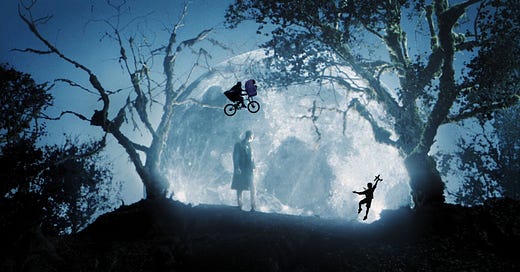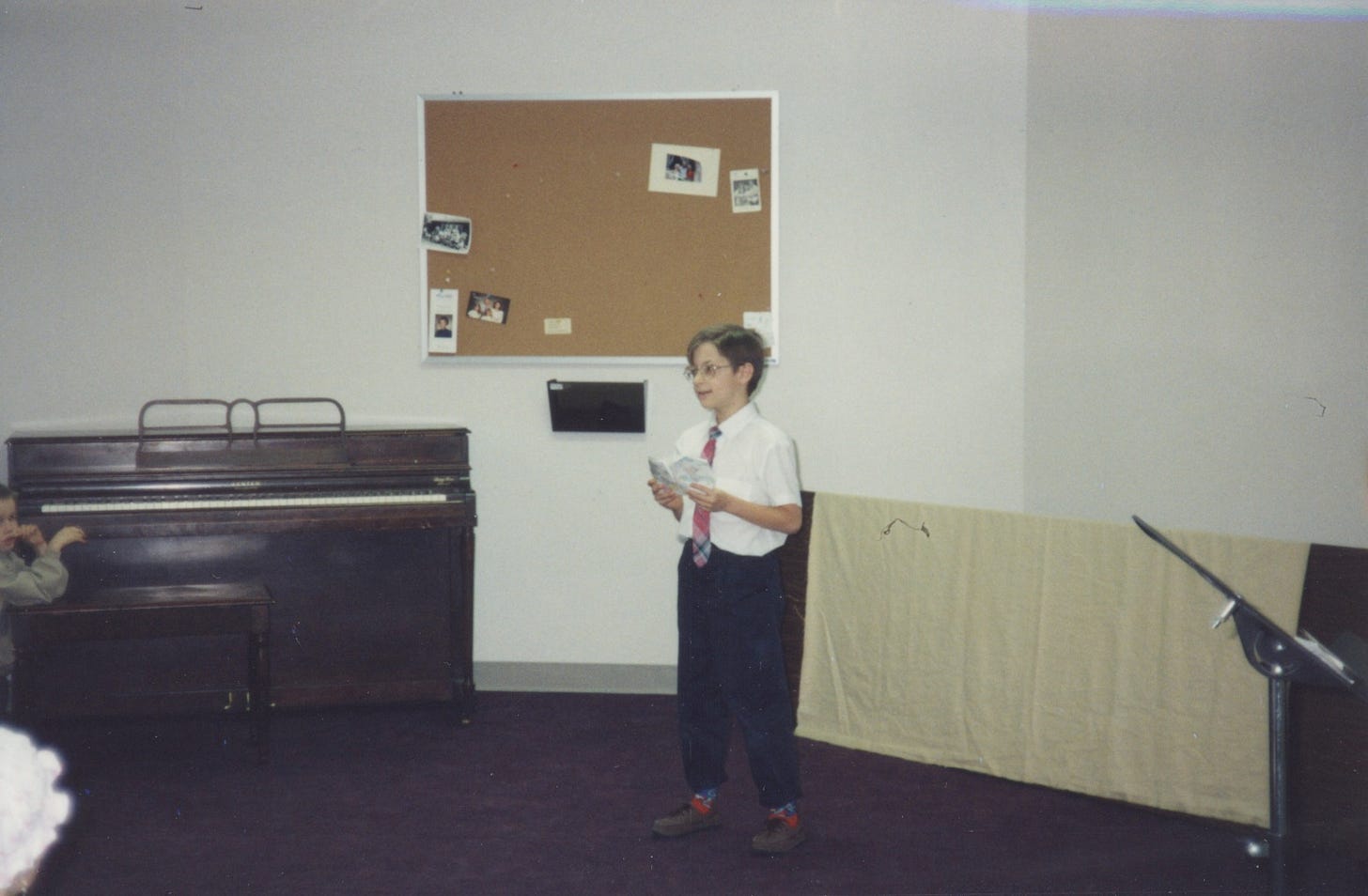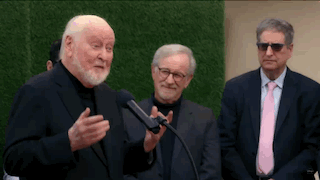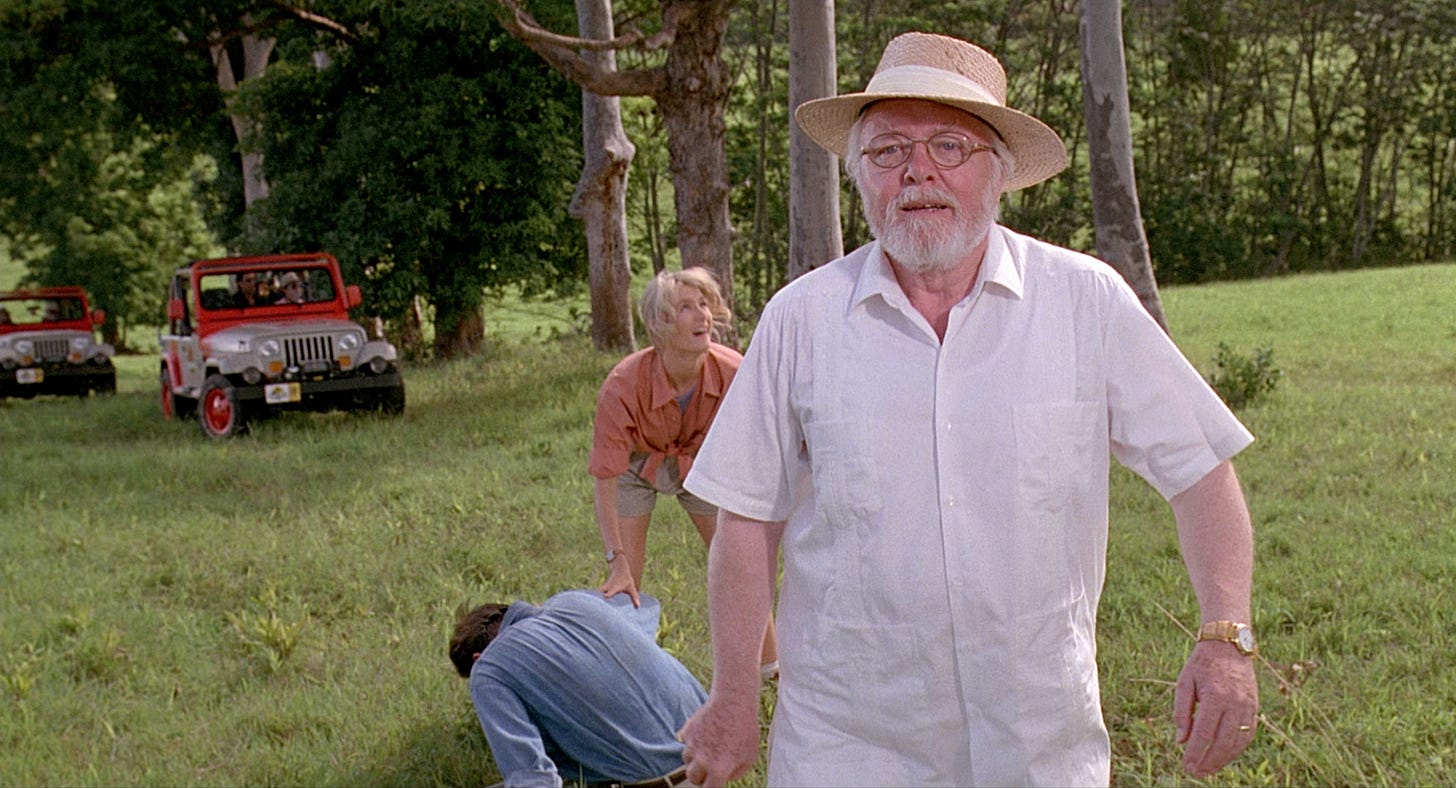Welcome behind the moon
The stories inside, outside, and behind my new biography of John Williams
There are so many moon shots in the films of John Williams. The most obvious, of course, is E.T. and Elliott silhouetted against a radiant moon as they cycle through the sky (which then became the logo for Steven Spielberg’s company, Amblin). In A.I., the Mecca-hunting character played by Brendan Gleeson flies around in a “moon balloon,” which results in more character silhouette shots against a faux lunar surface; Gigolo Joe tells a frightened David that they must travel towards the moon in order to get to Rouge City where, hopefully, David can find the Blue Fairy. The Death Star in Star Wars sure looks like one, but as we all know: “That’s no moon.” Endor, though, is.
The moon turns Professor Lupin into his werewolf self in Harry Potter and the Prisoner of Azkaban. There’s a lunar eclipse toward the end of Angela’s Ashes, giving way to an exquisite, dreamlike string chorale. When the titular War Horse, Joey, runs frantically through the fray of battle, he is dramatically lit by cannon fire and moonlight. Indiana Jones travels to the Canyon of the Crescent Moon to look for the Holy Grail. John wrote a song called “Moonlight” for Sabrina to dance to, and he composed an even more obscure song for a lyric by the poet Rita Dove, which states: “When I was young, the moon spoke in riddles and the stars rhymed.”
The moon is indeed a riddling creation, a powerful visual to inspire music… and it felt like the right metaphor when I was thinking about this Substack, a new weekly column in tandem with my forthcoming biography of John Williams (out on September 2nd!). Even though the natural object that John is most strongly associated with is trees—a prominent motif in my book—the moon clearly looms large in his work, and I wanted to paint the image of taking you behind the moon for this chronicle of not only his life and work, but of my journey toward capturing it. The moon holds riddles of ancient magic and ancestral adventures, but it’s also the stuff of nursery rooms and lullabies… of childhood dreams.
(You can pre-order my book through Oxford University Press website or Amazon.)
The saga of not only getting to write a book about John Williams, but then of convincing him to participate, has been an epic odyssey full of highs and lows and many surprises and mind-blowing delights. I wanted to create an online place where I could share portions of that Homeric tale, but also tell stories that just couldn’t fit in the book, as well as highlight fun, quirky, incredible, or moving elements from the biography as a way of whetting your appetite for its eventual publication.
I spent nearly two years interviewing John at great length, mostly in his bungalow studio at Amblin on the Universal Studios lot—sitting next to the piano where he composed the score for Jurassic Park—but also in the living room / piano room in the home where he’s lived since the early 1970s. I sat with him in a building at Tanglewood where he used to eat dinner and share ghost stories with Leonard Bernstein. I spoke with him in a hotel suite in Tokyo where he—at age 91—flew to conduct a concert and visit his dying friend, Seiji Ozawa. I sat on the scoring stage at Sony (the old MGM) where he recorded a new tone poem written for Yo-Yo Ma.
This is a man I have worshiped since I was nine. I’ve spent the majority of my life listening to his music and (literally) dreaming about meeting him; so many dreams of just sitting and chatting with him, always followed by waking up to cold reality and feeling genuinely sad that it would never come true. I slapped together a whole career where I write about film music and interview its composers—because of him.
It was all building toward this impossible dream: to write a book about him, and to involve him in the process. Over the course of a decade I asked three times, and each time I was told, unequivocally, no. “It has nothing to do with you, Tim,” his agent told me. “He just has no interest in any kind of biography or documentary about his life.”
So how did it happen?
—
I was born smack dab in the middle of the Eighties, at the tail end of 1984, which made me eight years old the summer that Jurassic Park came out. Too young to see it in theaters, my parents thought, so my first exposure to the dino blockbuster was actually hearing the soundtrack album—in glorious cassette fidelity—in my cousins’ minivan while on a family vacation the following summer in Orlando, Florida.
Besides not having seen the movie yet, the whole concept of films having original scores created by living composers was revolutionary and fascinating to me, all of which was helpfully explained by my oldest cousin, Matt. And as he explained that there was this guy named John Williams who also wrote the music for Star Wars and Indiana Jones and Jaws and Hook, it dawned on me that I already (subconsciously) knew this man and loved his work. When I got back home to Parker, Colorado, that summer, I went out and bought my own Jurassic Park soundtrack on cassette. Soon after, we were at the home of some elder church friends, and I spied a CD: By Request… The Best of John Williams and the Boston Pops. The lady kindly gifted it to me, and when I inserted it into the CD player I was greeted with and instantly enchanted by his rousing themes for The Cowboys, Midway, 1941, the 1984 Olympics, and NBC News, along with several melodies I already knew from Star Wars and Raiders of the Lost Ark. The needle was in; another film score junkie was born.1
Or to be more precise, a John Williams junkie. It was all about John for the first several years. I used my allowance money to buy his soundtrack cassettes and CDs; I would create mixtapes of my favorite tracks from various albums, and I would air-conduct with them blasting on my bedroom stereo or in the family van. Eventually my love of his music led to a broader obsession with film music, that mysterious, unsung, undervalued art form—and while I loved playing the piano and dabbled with the idea of becoming a composer myself, I eventually gravitated toward a career in writing words about film music and its composers. A film music evangelist, as I call myself.
But it all started and ends with John Towner Williams—my favorite artist at age nine, and still my favorite artist at age forty.
Writing a book about him seemed like the absolute Mt. Everest of goals when my writing career began in earnest—and it also quickly became obvious that it would never happen. Getting interview access to the man was almost impossible for anything (I eventually scored a few interviews for a few different articles and radio stories), but no one was going to be allowed to write a biography. He didn’t want it to happen.
There was a long, winding, crazy-making trail (which I am only hinting at for now), the trail between the outright impossibility of this wish-upon-a-star dream and the late morning in October, 2022, when he met me at the door to his bungalow in Universal City…
—
So what is this thing?, you ask.
Behind the Moon is a guided flight behind my book on John Williams and all of the things I learned about him and his life and work—much of which I wasn’t able to include in the book itself. I want to get you hyped for the biography itself, of course, but also share a bevy of fun stories, pieces of trivia, fascinating connections, anecdotes, video and audio clips, photos, interview quotes, archival news stories, and lots of other rare and exclusive arcana that I gathered during the five years of researching and writing this bad boy. I will also share what I hope are entertaining and revealing insights about the experience of working on the book, the people I interviewed and discoveries I made along the way... and of course, my lengthy and life-changing experience of spending time with the man himself.
I also have designs on celebrity interviews and guest columns. Maybe even a companion podcast!
This is a free wordstream—to steal a quote from John, “It’s a river we can all put our cups into and drink it and be sustained by it”—but I would obviously be very helped (and flattered) if you would consider subscribing for $5/month. It would make a genuine difference in my ability to keep up with this project; believe me, as a freelance journalist every 5 bucks matters. If you choose to pay, I want to thank you very much and promise that I’ll create regular material that is worth the cost. I’ll even take requests! (Seriously: if you have specific questions or want to know about a particular topic, the phones, as they say, are open.)
I’ll deliver a new post every Tuesday, from here to the publication date (Tuesday, September 2, 2025) and beyond. Who knows where it will go, but I’m sitting on an overflowing treasure chest of moonlit gold, so there’s no fear of running out of material. It may eventually grow into something beyond solely John Williams content (I plan on, at the least, doing an occasional tangent)—but I know it will be a fun ride!
Welcome… to Behind the Moon.
I stole this line from my own book, where it actually refers to one Steven Spielberg.










Excited! I love him, I love this.
Brilliant.